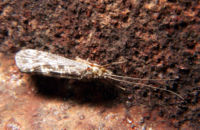
Photo from wikipedia
Abstract Lotic ecosystems in urban areas are severely impacted by anthropogenic environmental stressors, such as deforestation and nutrient pollution, due to socioeconomic activities in the catchment. To work out measures… Click to show full abstract
Abstract Lotic ecosystems in urban areas are severely impacted by anthropogenic environmental stressors, such as deforestation and nutrient pollution, due to socioeconomic activities in the catchment. To work out measures for identification and mitigation of concurrent multiple stressors to a stream system, it is necessary to assess the relative importance of impacts by the individual stressors. Here we aimed to discriminate the covarying effects of nutrient pollution and deforestation on benthic macroinvertebrate communities in an urbanised tropical stream system. In the Silang-Santa Rosa Subwatershed (SSRS) of Laguna de Bay, benthic macroinvertebrates and physicochemical environments were investigated at 13 sites varying in human population density, riparian canopy, and land-use pattern as indicated by geographic information systems in the catchment. Regression and multivariate analyses were performed to identify the drivers of the biodiversity loss and understand its underlying mechanisms. In the SSRS, where rapid economic growth took place without updating poorly installed wastewater treatment plants (WWTPs), domestic activity indicated by human population density in the catchment was the primary factor in generating heavy phosphorous loadings (mean total phosphorus = 0.91; range = 0–1.50 mg/l) that caused hypoxia (mean dissolved oxygen = 2.98; range = 0.13–6.27 mg/l) in stream waters and subsequently reduced macroinvertebrate diversity (mean H’ = 0.91; SD ± 0.61). Nutrient and organic pollution and riparian deforestation explained 53.5% and 9.7% of the variation of benthic macroinvertebrate communities in SSRS, respectively. Given such scenario, additional WWTPs servicing urban developments and improved riparian canopy cover in the SSRS can be both strategic and cost-effective in the initial steps of environmental mitigation in urbanised streams, especially in rapidly developing countries.
Journal Title: Limnologica
Year Published: 2020
Link to full text (if available)
Share on Social Media: Sign Up to like & get
recommendations!